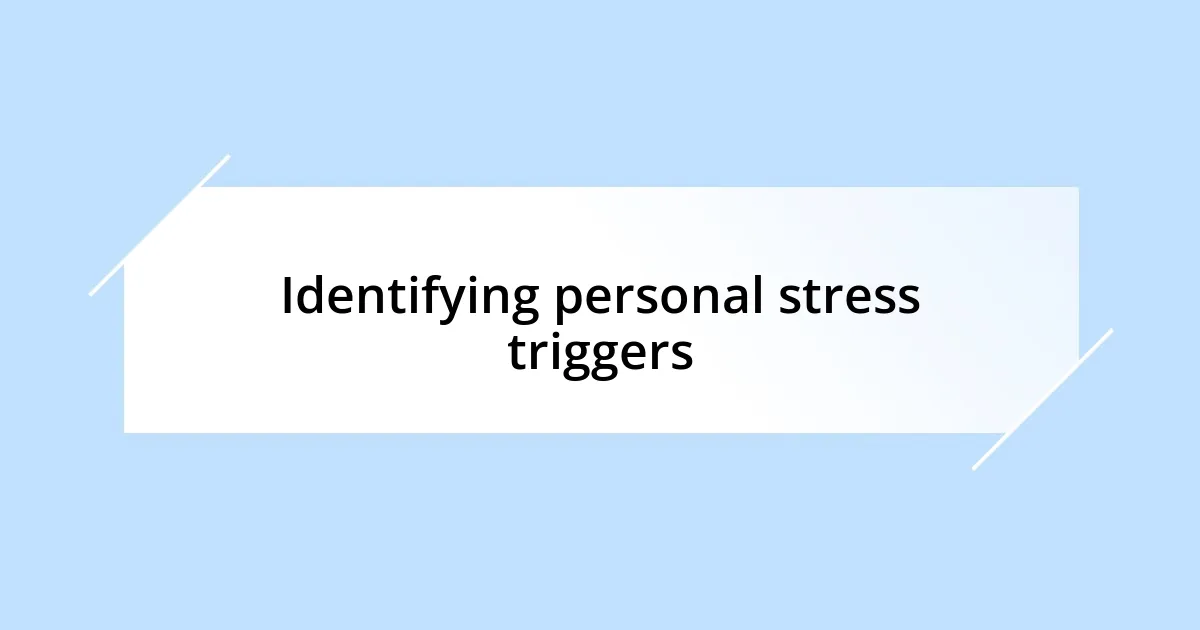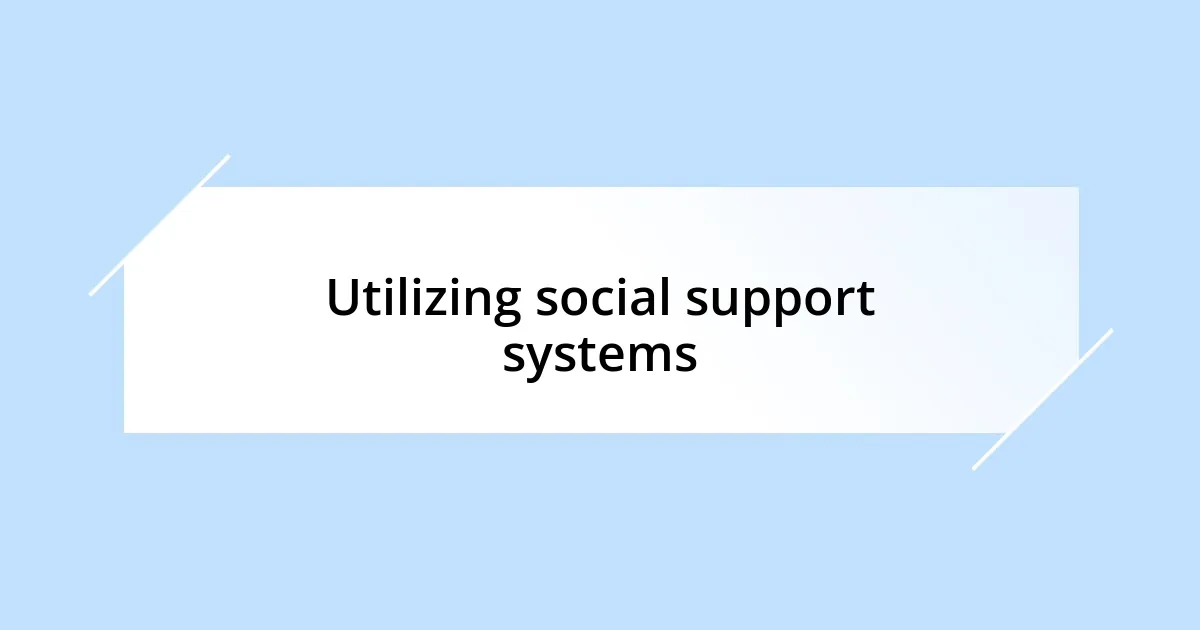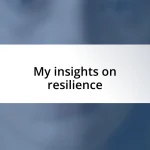Key takeaways:
- Mindfulness meditation and physical activity are effective techniques for managing stress and enhancing emotional clarity.
- Identifying personal stress triggers helps in developing tailored coping strategies and emotional responses.
- Creating a personalized stress plan, including setting boundaries and incorporating relaxation techniques, is essential for effective stress management.
- Utilizing social support systems and evaluating stress strategies can strengthen resilience and improve mental well-being.

Understanding stress management techniques
Understanding stress management techniques is crucial for navigating life’s challenges with resilience. For instance, when I first discovered mindfulness meditation, it was like stumbling upon a hidden treasure. The moment I began focusing on my breath, I noticed how it helped not only calm my racing thoughts but also allowed me to reconnect with the present moment. Have you ever tried just sitting in silence and noticing what your body is telling you?
There are countless strategies out there, from deep breathing exercises to progressive muscle relaxation. I remember a time when I used to carry the weight of deadlines and expectations like a heavy backpack. Implementing even a few minutes of these techniques during my day transformed my anxiety into manageable moments of clarity. Have you considered which technique resonates most with your lifestyle?
Another powerful tool in my toolkit has been physical activity. I once attended a yoga class merely out of curiosity, and to my surprise, it provided a blend of physical exertion and mental release. The gentle stretching not only soothed my muscles but also cleared the mental clutter. How do you prefer to move your body? Finding the right stress management technique often requires some exploration, and that’s entirely okay.

Identifying personal stress triggers
When I began the journey of pinpointing my stress triggers, I realized that certain situations consistently heightened my anxiety. For example, I noticed that large crowds or unexpected changes in plans left me feeling overwhelmed. Recognizing these patterns was like shining a light on hidden obstacles; it allowed me to prepare and develop coping strategies for those specific stressors.
One particularly enlightening moment came when I kept a journal tracking my feelings over a few weeks. I was astonished to see how often work-related pressures escalated my stress levels, particularly during busy seasons. It made me reflect on the importance of setting boundaries and prioritizing self-care during those hectic times. Have you ever considered how your environment influences your stress?
Compiling a list of my triggers wasn’t just about identifying them—it also helped me create a roadmap for managing my emotional responses. For example, understanding that harsh criticism affects my self-esteem has empowered me to practice self-compassion. Each new realization allows me to approach my stressors with a clearer mindset, and I can take proactive steps towards a healthier response.
| Trigger | Emotional Response |
|---|---|
| Large Crowds | Overwhelm |
| Work Pressures | Anxiety |
| Harsh Criticism | Low Self-Esteem |

Developing a personalized stress plan
Creating a personalized stress plan is an essential step towards managing anxiety effectively. For me, it all began with a simple self-assessment—what works for one might not work for another. I sat down one day with a list of activities I enjoyed and their effects on my mood. To my surprise, some techniques I thought might help didn’t resonate, while others became lifelines during stressful times.
- **Identify routines**: I found that incorporating short walks during lunch breaks not only lifted my spirits but also cleared my mind for the afternoon.
- **Practice flexibility**: Allowing flexibility in my schedule helped me manage unexpected stressors when life threw curveballs. It was liberating!
- **Set boundaries**: Learning to say “no” to excessive commitments was a game-changer. I remembered how draining it felt to stretch myself too thin, and now I guard my time fiercely.
- **Incorporate relaxation techniques**: I’ve woven deep breathing exercises into my daily routine, even if it’s just for five minutes. Each time, I feel a wave of calm wash over me.
As my personalized stress plan evolved, it became clear I needed periodic reflections to gauge what was working. I began dedicating a few moments each week to review how I felt. A light bulb moment happened when I realized that my late-night reading habit often helped unwind my racing mind better than screen time. Adjusting my plan even slightly led to significant changes in my stress levels, which surprised me.

Practicing mindfulness and meditation
Practicing mindfulness and meditation has been a game changer for me in managing stress. I remember the first time I committed to a daily meditation session; it felt like stepping into a quiet sanctuary amidst the chaos of life. Just a few minutes of focused breathing made a noticeable difference, allowing me to approach challenges with a calmer mind. Have you ever tried to simply sit in silence and tune into your breath? It’s surprisingly transformative.
Incorporating mindfulness into my daily routine has brought a heightened awareness of my thoughts and feelings. One memorable moment was during a particularly hectic day at work when I felt my anxiety creeping in. Instead of succumbing to the pressure, I took a brief pause to practice mindfulness. I tuned in to my surroundings—the sound of the clock ticking, the soothing rhythm of my own breath. This simple act grounded me, reminding me that I could reclaim control even when circumstances felt overwhelming.
Meditation doesn’t need to be lengthy or complicated. I often find that a quick five-minute session is enough to reset my mental state. Some days, I use guided meditations, while other times, I simply listen to calming music. Each approach has its place, depending on how I feel. It’s comforting to know that there’s no right or wrong way to practice; it’s all about what resonates with me. Have you found a method that feels right for you? The journey of discovering what helps can be as enriching as the practice itself.

Incorporating regular physical activity
Incorporating regular physical activity into my routine has been a transformative experience for managing stress. I vividly remember the first time I returned to jogging after a long break. With each step, I could feel the tension begin to dissipate, replaced by a wave of endorphins that lifted my mood. It’s astonishing how just a simple run can shift my perspective and make the burdens of the day feel lighter. Have you ever felt that high after a good workout? It’s genuinely addictive!
I’ve experimented with different types of physical activities to see what resonates with me. One of my favorites is yoga; it blends movement with mindfulness in a way that feels incredibly grounding. There was a time when I struggled with sleepless nights, tossing and turning endlessly. But after a few yoga sessions focused on relaxation, I finally understood how intentional movement could soothe my racing mind. The act of stretching and breathing deeply allowed me to release pent-up tension, often leading me to a peaceful night’s sleep. Reflecting on these moments, I’ve realized how discovering the right form of exercise can be a game-changer in one’s stress management toolkit.
Staying active doesn’t have to be a chore—it should be something you look forward to. I’ve found immense pleasure in dance classes, where I not only burn calories but also connect with others. The laughter and energy in the room create a joyful atmosphere, transforming stress into pure fun. Have you found an activity that brings you joy rather than dread? For me, it’s all about embracing movement in a way that feels natural and enjoyable. The key is to listen to your body and find what sparks joy—exercise can be an effective remedy for stress when it feels less like a punishment and more like a celebration of what our bodies can do.

Utilizing social support systems
Utilizing social support systems has been invaluable in navigating stressful times. I recall a particularly challenging week at work when everything felt overwhelming. Instead of isolating myself, I reached out to a close friend who listened patiently and offered insights that I hadn’t considered. It was a simple yet powerful reminder that sharing my burdens lightens the load. Have you ever experienced that? Just talking it out can make such a difference.
Building and maintaining a supportive network is something I actively prioritize. Whether it’s scheduling regular coffee dates with friends or joining group activities, I find that these connections anchor me during turbulent times. There was a period when I felt disconnected and anxious, but engaging in a weekly book club not only filled my schedule but also fostered new friendships that helped me feel more grounded. It’s incredible how a shared interest can lead to deeper bonds, don’t you think? It’s those shared laughs and conversations that truly uplift our spirits.
Whenever I find myself feeling stressed, I remind myself to tap into my social support. One time, during a family crisis, I gathered my loved ones for an impromptu dinner. Together, we shared our worries and reassured one another, transforming fear into strength as we recognized we weren’t alone. This experience taught me that vulnerability can bridge the gaps between us. It’s comforting to know that in our most challenging moments, we can lean on one another and find solace in our connections. Have you considered reaching out when times get tough? You might discover the incredible strength of community that you never realized was there.

Evaluating and adjusting stress strategies
Evaluating the effectiveness of my stress management strategies is something I’ve learned to do regularly. I remember a time when I was convinced that journaling was my lifesaver for stress relief. Yet, after a few months, I noticed I wasn’t reaping the emotional benefits I expected. It pushed me to ask myself: was I writing with purpose, or was it just another task on my to-do list? Reflecting on my intentions and the results of this practice taught me that evaluation is crucial in knowing what genuinely serves my well-being.
There are moments when I realize that not every strategy I try will click. For instance, I once started meditating every day, thinking it would provide calm amidst chaos. However, I often found my mind wandering, which only added to my frustration. So, I decided to adjust my approach by incorporating guided meditation instead. This small change made a significant difference, as having someone else guide me through the process helped keep my focus. Have you ever had to tweak your approach to find what truly works for you? It’s like experimenting in the kitchen—sometimes, a little adjustment can elevate the whole dish.
When I take the time to assess my stress strategies, it often opens new doors. Recently, I revisited an old hobby: painting. Initially, I was skeptical about its impact. But as soon as those brushes hit the canvas, I realized that creative expression provided a form of therapy I hadn’t recognized before. I ask myself, “What brings me joy?” This simple question helps me fine-tune my strategies, always guiding me back to the activities that genuinely resonate. By evaluating my choices, I continuously refine my toolkit for better mental health. How often do you reevaluate your own stress management techniques? It might just lead to discovering something beautiful.












